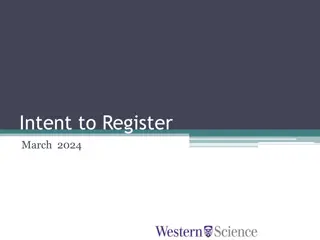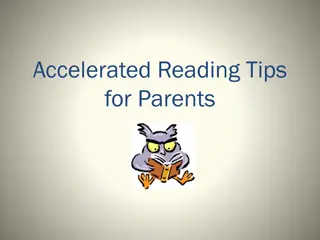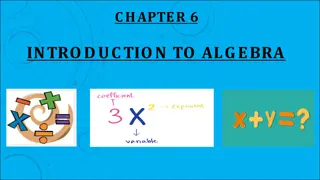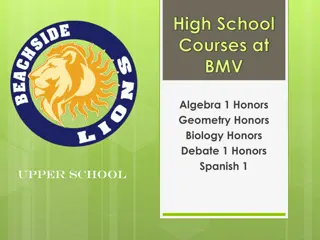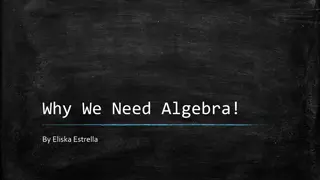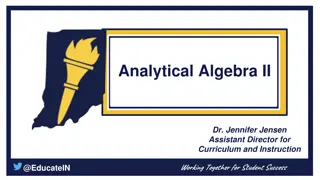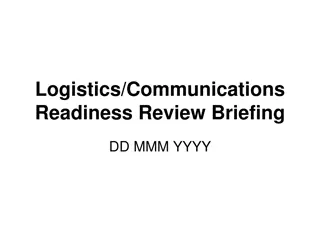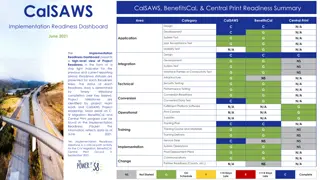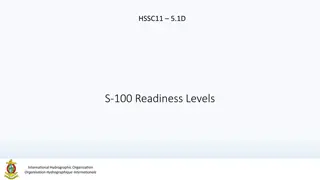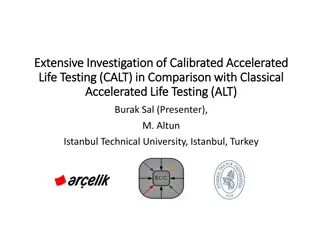Algebra 1 Honors Readiness and Accelerated Student Path Overview
Understand the importance of Algebra 1 Honors preparation, required concepts, and graduation criteria. Dive into the accelerated student path standards post 6th grade. Topics include fractions, equations, proportions, statistics, and probability. Ensure readiness for a successful Algebra 1 journey.
Download Presentation

Please find below an Image/Link to download the presentation.
The content on the website is provided AS IS for your information and personal use only. It may not be sold, licensed, or shared on other websites without obtaining consent from the author.If you encounter any issues during the download, it is possible that the publisher has removed the file from their server.
You are allowed to download the files provided on this website for personal or commercial use, subject to the condition that they are used lawfully. All files are the property of their respective owners.
The content on the website is provided AS IS for your information and personal use only. It may not be sold, licensed, or shared on other websites without obtaining consent from the author.
E N D
Presentation Transcript
Algebra 1 is the first in a series of higher- level math classes students need to succeed in college and life. Due to the increasing number of middle grade students taking Algebra 1 Honors the Mathematics Department would like to provide parents and students with a grasp of the fundamental math concepts that are needed to succeed in Algebra 1. To ensure that your student is adequately prepared for the cognitive demands and level of rigor of the Algebra 1 Honors course, the Math Department has developed an Algebra 1 Readiness packet . The purpose of this resource is to allow students the opportunity to dive a little deeper into the pre-requisite algebraic skills.
Algebra 1 Honors Important Facts Algebra 1 Honors is a High School course. Algebra 1 is a required credit for graduation. Students must pass the Algebra I end-of- course (EOC) for graduation. The results of the Algebra 1 EOC constitute thirty percent of the final course grade.
Accelerated Student Path 6th Grade Student Algebra 1 Honors These are the standards students miss due to acceleration after completing 6th grade mathematics: MAFS.7.EE.1.1 MAFS.7.EE.1.2 MAFS.7.EE.2.3 MAFS.7.EE.2.4 MAFS.7.NS.1.1 MAFS.7.NS.1.2 MAFS.7.NS.1.3 MAFS.7.RP.1.1 MAFS.7.RP.1.2 MAFS.7.RP.1.3 MAFS.7.SP.1.1 MAFS.7.RP.2.3 MAFS.7.RP.3.5 MAFS.7.RP.3.6 MAFS.7.RP.3.7 MAFS.7.RP.3.8 MAFS.8.F.1.1 MAFS.8.F.1.2 MAFS.8.F.1.3 MAFS.8.F.2.4 MAFS.8.F.2.5 MAFS.8.NS.1.1 MAFS.8.NS.1.2 MAFS.8.SP.1.1 MAFS.8.SP.1.2 MAFS.8.SP.1.3 MAFS.8.SP.1.4 MAFS.8.EE.1.1 MAFS.8.EE.1.2 MAFS.8.EE.2.5 MAFS.8.EE.2.6 MAFS.8.EE.3.7 MAFS.8.EE.3.8
Accelerated Student Path 6th Grade Student Algebra 1 Honors 7th Grade content students miss due to acceleration: Add and subtract numeric expressions that contain fractions Rewrite expressions in different ways Solve equations that require multiple steps with positive and negative whole numbers, fractions, and decimals Create an equation or inequality to solve a real world problem Find the distance between two numbers (whole numbers, fractions, or decimals) on the number line and know that its absolute value is their difference. Add, subtract, multiple, and divide positive and negative fractions in a real-world context problem Compute unit rates and describe them as a fraction and ration (i.e. 2:3) Recognize or describe when a relationship is proportional in a table, graph, equation, diagram, or verbal description Solve multi-step ratio and percent problems (i.e. simple interest, tax, markups, gratuities, commission, fees, percent increase, and percent decrease) Understand that statistic can be used to gain information to support inferences Compare data represented as a box plot and make inferences on the data Understand probability where 0 indicated unlikely and event will occur and 1 indicates certainty Approximate the likelihood that an event will occur by collecting data Develop a probability model (i.e. spinner) to generate data, explain possible sources of discrepancies, or determine the likelihood of an event Find the probability of an event that is dependent to another event using list, tables, tree diagrams
Accelerated Student Path 6th Grade Student Algebra 1 Honors 8th Grade content students miss due to acceleration: Convert decimals into fractions and know that some decimals may not be converted into a fraction, also known as an irrational number. Find the square root and cube root to perfect values Approximate the value of square root on a number line. Calculate the value for a whole number with a positive or negative exponent. Graph a line and interpret its meaning in a real-world context while referring to the slope of the line Explain the slope of a line by using similar triangles Solve equations that contain whole numbers, fractions, or decimals that may have one solution, infinitely many solutions, or no solution. Apply the distributive property and combining like terms Solve for a pair of equations simultaneously algebraically or in real-world context and explain the solution. Write the rule (function), where each value that is input provides exactly one output Represent a function algebraically, by graphing, in a table of values, or verbal description Provide examples of functions that are not linear In real-world context determine the rate of change and initial values of a function Describe a function by looking at a graph Create a graph for a verbal description of a function
Accelerated Student Path 6th Grade Student Algebra 1 Honors 7th grade sample questions of content that students miss due to acceleration: 1. The cost of a barrel of beans, b, fluctuates by 17% in both directions during a three-month period. Match each verbal description of the high and low cost of a barrel of beans with all equivalent expressions. ? + ?.??? ? ?.??? ? ?.??? ?.??? ?.??? ?.??? b is increased by 17% b is decreased by 17% 3. What is 2 2. The total change in the price of a certain brand of cereal from 2008 to 2012 was -$0.20. complete the table to show possible price changes in 2010 and 2012. Year 3 written as a decimal? 0.23 A Change in Dollars 0.6 0. 6 B C 2008 +0.20 1.5 D 2009 +0.30 2010 -0.40 2011 -0.20 2012 -0.10 Total -0.20
Accelerated Student Path 6th Grade Student Algebra 1 Honors 7th grade sample questions of content that students miss due to acceleration: 4. An expression I shown, where ? < 0 and c > 0. ? + ? = ? Drag the two points to the number line to show possible locations of a and b. a c b 0 5. The dimensions of a rectangular pool are 24.5 feet by 13 feet. The depth of the water is 4 feet. Each cubic foot cotains7.48 gallons of water. How many gallons of water, to the nearest tenth, are needed to fill the pool to 80% capacity? 6. An expression is shown. 3 5? + 3 2 3? 1 2 Create an equivalent expression without parentheses.
Accelerated Student Path 6th Grade Student Algebra 1 Honors 8th grade sample questions of content that students miss due to acceleration: 7. An equation is shown. 9. Determine whether each number is rational or irrational. 3? 3?= 3 2 What are possible values for m and n? Rational Irrational 81 89 121 131 10. Drag the numbers shown to their approximate location on the number line. 8. Create a table of values to show a relation that is not a function. 2 3 x y 0 1 2 3
Accelerated Student Path 7th Grade Student Algebra 1 Honors These are the standards students miss due to acceleration after completing 7th grade mathematics: MAFS.8.EE.1.1 MAFS.8.EE.1.2 MAFS.8.EE.1.3 MAFS.8.EE.1.4 MAFS.8.EE.2.5 MAFS.8.EE.2.6 MAFS.8.EE.3.7 MAFS.8.EE.3.8 MAFS.8.F.1.1 MAFS.8.F.1.2 MAFS.8.F.1.3 MAFS.8.F.2.4 MAFS.8.F.2.5 MAFS.8.NS.1.1 MAFS.8.NS.1.2 MAFS.8.SP.1.1 MAFS.8.SP.1.2 MAFS.8.SP.1.3 MAFS.8.SP.1.4
Accelerated Student Path 7th Grade Student Algebra 1 Honors 8th Grade content students miss due to acceleration: Convert decimals into fractions and know that some decimals may not be converted into a fraction, also known as an irrational number. Find the square root and cube root to perfect values Approximate the value of square root on a number line. Calculate the value for a whole number with a positive or negative exponent. Graph a line and interpret its meaning in a real-world context while referring to the slope of the line Explain the slope of a line by using similar triangles Solve equations that contain whole numbers, fractions, or decimals that may have one solution, infinitely many solutions, or no solution. Apply the distributive property and combining like terms Solve for a pair of equations simultaneously algebraically or in real-world context and explain the solution. Write the rule (function), where each value that is input provides exactly one output Represent a function algebraically, by graphing, in a table of values, or verbal description Provide examples of functions that are not linear In real-world context determine the rate of change and initial values of a function Describe a function by looking at a graph Create a graph for a verbal description of a function
Accelerated Student Path 6th Grade Student Algebra 1 Honors 8th grade sample questions of content that students miss due to acceleration: 1. Select the number if solutions for each system of two linear equations. Infinitely many solutions Zero Solutions One Solution 2? + 2? = 3 4? + 4? = 6 7? + 5? = 8 7? + 7? = 8 2? + 3? = 7 2? + 3? = 7 3. The function ? = 3.50? + 2 represents the total amount of money, y, saved over x weeks. 2. What is the distance, in units, between A (-1,3) and B (3,5)? What is true about the function? It is linear because it is always increasing. A It is linear because it increases at a constant rate. B It is nonlinear because it is always increasing. C It is nonlinear because it at a constant rate. D
Accelerated Student Path 6th Grade Student Algebra 1 Honors 8th grade sample questions of content that students miss due to acceleration: 4. Five hundred students were asked whether they prefer apple or orange juice. The table shown displays the results. 5. Kayden creates a linear function where x is the input, y is the output, and m and b are constants. A. Which equation could represent Kayden s function? Orange Juice Apple Juice Total 1 ?+ ?? ? = Boys 30 100 ? = ?? + ? ? = ?? ?? B. Which statement about the graph of Kayden s function is true for all values of m and b? Girls 210 160 Total How many more girls were surveyed than boys? The graph is increasing. The graph is decreasing. The graph goes through the origin. The graph has a constant rate of change.
The Algebra 1 Readiness Packet reviews 8th grade content that is necessary to be successful in Algebra 1. The packet consist of six pillars that address key domains in 8th grade. The next few slides will depict what the packet is composed of.
Pillar 1 Pillar 4 MAFS.8.EE.1.1 MAFS.8.NS.1.1 MAFS.8.NS.1.2 MAFS.8.F.2.4 MAFS.8.F.2.5 Pillar 2 Pillar 5 MAFS.8.EE.3.7a MAFS.8.EE.3.7b MAFS.8.EE.3.8a MAFS.8.EE.3.8b MAFS.8.EE.3.8c MAFS.8.F.1.1 Pillar 3 Pillar 6 MAFS.8.F.1.3 MAFS.8.SP.1.1 MAFS.8.SP.1.2 MAFS.8.SP.1.3 MAFS.8.SP.1.4 MAFS.8.EE.2.5 MAFS.8.EE.2.6 MAFS.8.F.1.2
Expand, simplify, and evaluate expressions involving exponents, including products and quotients raised to powers Prove the rules of exponents for multiplying and dividing exponents with the same base by using the definition of an exponent. Generate and use the rules for multiplying and dividing powers with the same base Generate and use the rules for zero exponents and negative exponents. You will be able to do the following things after this lesson. AL The Robot Guide Pillar Roadmap Vocabulary Next Steps? Check Yourself
Parent Letter Pillar Roadmap Answer Key
Accessing the Algebra 1 Readiness Resources Teacher Access



